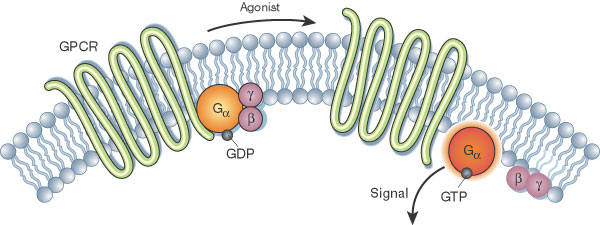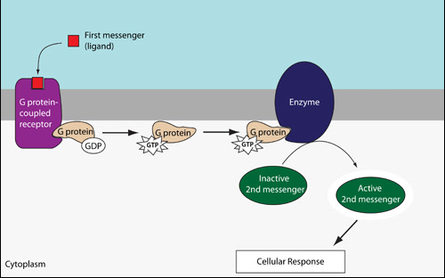What do you mean by G-protein coupled receptor ?

Integral membrane proteins, G protein-coupled receptors (GPCRs) have an intracellular carboxy terminus, seven transmembrane α-helical domains, and an external amino terminus. G-protein coupled receptor are capable of identifying a large range of signals, including ions, photons, proteins, neurotransmitters, and hormones.
The β-adrenergic signaling pathway is a critical component of the body’s response to stress and exertion, orchestrating a range of physiological changes that help us cope with these challenges. This pathway is activated by the binding of adrenaline (epinephrine), a hormone released by the adrenal glands, to a family of proteins known as β-adrenergic receptors (β-ARs). These receptors belong to the large and diverse class of G-protein coupled receptors (GPCRs), which play crucial roles in mediating cellular responses to a wide array of stimuli.
Table of Contents
The Cast of Characters of G-Protein coupled receptors
β-Adrenergic Receptors (β-ARs): These are the gatekeepers of the pathway, responsible for receiving the signal from adrenaline. There are three major subtypes of β-ARs: β1, β2, and β3, each with distinct tissue distribution and signaling properties.
β1-AR: Primarily found in the heart, where it increases heart rate and contractility.
β2-AR: Abundant in smooth muscle, particularly in the bronchioles, where it relaxes the airways. It also plays a role in regulating blood sugar levels.
β3-AR: Predominantly located in adipose tissue, where it promotes lipolysis, the breakdown of fat for energy.
G-proteins: These molecular switches act as intermediaries, transmitting the signal from the β-AR to downstream effectors. G-protein coupled receptor are heterotrimeric, consisting of three subunits: α, β, and γ. In the resting state, the α subunit is bound to GDP. Upon activation by the β-AR, the α subunit exchanges GDP for GTP, dissociates from the βγ complex, and interacts with its effector proteins.

Adenylate cyclase: This enzyme is activated by the α subunit of the G-protein, leading to the production of cyclic adenosine monophosphate (cAMP) from ATP. cAMP acts as a second messenger, amplifying and transmitting the signal within the cell.
Protein kinase A (PKA): This enzyme is activated by cAMP and phosphorylates specific target proteins, initiating a cascade of intracellular events. PKA plays a central role in regulating a variety of cellular processes, including gene expression, metabolism, and cellular growth.
Downstream effectors: The actions of PKA are highly specific, targeting different proteins in different tissues, leading to a diverse array of physiological effects.
The Play: A Detailed Walkthrough
Signal Reception: Adrenaline, released in response to stress or exertion, binds to β-ARs on the cell surface.
G-protein Activation: This binding event triggers a conformational change in the β-AR, which in turn activates the G-protein coupled receptors associated with it. The α subunit of the G-protein exchanges GDP for GTP, dissociates from the βγ complex, and becomes active.
Adenylate Cyclase Stimulation: The activated α subunit interacts with adenylate cyclase, stimulating its activity.
cAMP Production: Adenylate cyclase converts ATP into cAMP, increasing the intracellular concentration of this second messenger.
PKA Activation: cAMP binds to and activates protein kinase A (PKA).
Protein Phosphorylation: PKA phosphorylates specific proteins, initiating downstream signaling pathways.
The Diverse Repertoire: Effects of the Pathway
The β-adrenergic signaling pathway leads to a wide range of physiological responses, depending on the specific tissue and the type of β-AR involved. Here are some prominent examples:
In the heart: β1-AR activation leads to increased heart rate (positive chronotropy), increased contractility (positive inotropy), and enhanced conduction velocity, boosting cardiac output and blood pressure.
In the lungs: β2-AR activation relaxes smooth muscle in the bronchioles, leading to bronchodilation, which facilitates airflow and improves breathing.
In the liver: β2-AR activation promotes glycogenolysis, the breakdown of glycogen into glucose, which increases blood sugar levels, providing energy for the body.
In adipose tissue: β3-AR activation stimulates lipolysis, the breakdown of fat for energy, contributing to energy mobilization during periods of stress.
In blood vessels: β2-AR activation leads to vasodilation, the widening of blood vessels, which reduces blood pressure and improves blood flow.
The Symphony Ends: Regulation and Termination
The β-adrenergic signaling pathway is tightly regulated to prevent excessive activation and maintain cellular homeostasis. Several mechanisms contribute to this regulation:
Desensitization
Prolonged exposure to adrenaline can lead to desensitization of β-ARs, reducing their responsiveness to further stimulation. This involves phosphorylation of the receptor by G-protein coupled receptor kinases (GRKs) and the subsequent binding of β-arrestin, which prevents further interaction with G-proteins.
Hydrolysis of cAMP
cAMP is broken down by phosphodiesterases, reducing its concentration and attenuating PKA activity.
Reuptake of adrenaline
Adrenaline is removed from the synapse by reuptake into nerve terminals or by degradation by enzymes such as catechol-O-methyltransferase (COMT).
The Importance of the Pathway: Beyond Stress and Exertion
The β-adrenergic signaling pathway plays a crucial role in various physiological processes, beyond its role in stress response. It is involved in regulating:
Blood pressure and heart rate: Ensuring adequate circulation and oxygen delivery to tissues.
Bronchodilation: Maintaining normal lung function and facilitating breathing.
Blood sugar control: Regulating glucose levels and providing energy for the body.
Metabolic regulation: Controlling the breakdown of fat and glycogen for energy production.
Immune response: Modulating inflammation and immune cell activity.
The Symphony in Dissonance: Clinical Implications
Dysregulation of the β-adrenergic signaling pathway is implicated in a range of diseases, including:
Hypertension: Excessive β1-AR activation can lead to high blood pressure.
Heart failure: Reduced β1-AR responsiveness can contribute to impaired cardiac function.
Asthma: Reduced β2-AR responsiveness can lead to bronchoconstriction and difficulty breathing.
Obesity: Dysregulation of β3-AR signaling can contribute to impaired fat metabolism.
Anxiety and panic disorders: Enhanced β-AR sensitivity can lead to heightened anxiety and panic attacks.
Therapeutic Opportunities: Modulation of the Pathway
Due to its crucial role in various physiological processes, the β-adrenergic signaling pathway is a target for a wide range of therapeutic interventions.
β-blockers
These drugs block the action of adrenaline on β-ARs, reducing heart rate, blood pressure, and bronchoconstriction. They are commonly used to treat hypertension, heart failure, and angina.
β2-agonists
These drugs stimulate β2-ARs, relaxing smooth muscle in the bronchioles and promoting bronchodilation. They are widely used to treat asthma and chronic obstructive pulmonary disease (COPD).
Modulators of cAMP signaling
Drugs that modulate the activity of adenylate cyclase, phosphodiesterases, or PKA can also influence the β-adrenergic signaling pathway, offering potential therapeutic benefits for various diseases.
Conclusion: A Complex and Essential Signaling System
The β-adrenergic signaling pathway, orchestrated by the intricate interplay of G-protein coupled receptor, cAMP, and PKA, exemplifies the sophisticated nature of cellular communication.
G-proteincoupled receptor (GPCR) act as crucial mediators of communication between the outside world and the inside of your cells. They play a vital role in a wide range of physiological processes, making them important targets for drug development.
Frequently Asked Questions(FAQ)
What do you mean by G-protein coupled receptors (GPCRs) ?
Integral membrane proteins, G-protein coupled receptors (GPCRs) have an intracellular carboxy terminus, seven transmembrane α-helical domains, and an external amino terminus. are capable of identifying a large range of signals, including ions, photons, proteins, neurotransmitters, and hormones.
Define G-protein in G-protein coupled receptor?
In G-protein coupled receptors, G proteins or guanine nucleotide-binding proteins, are a class of proteins that function as molecular switches within cells, transferring signals from the outside of the cell to its interior in response to a range of stimuli.
Related Articles

